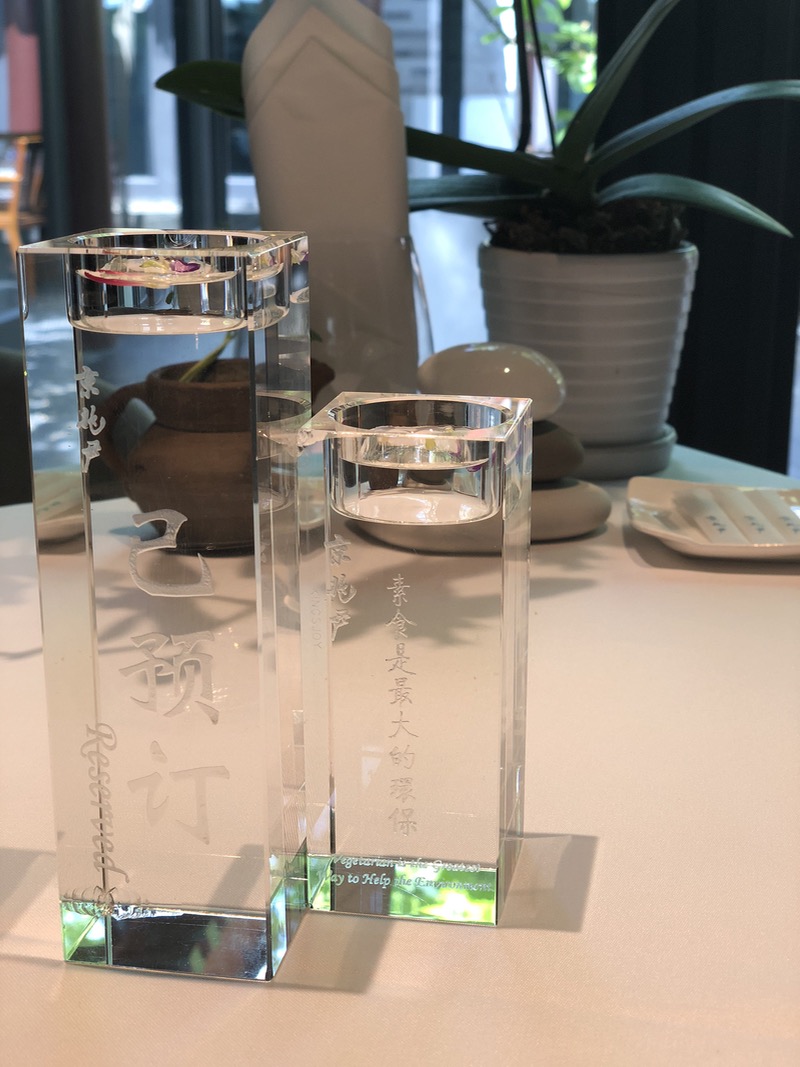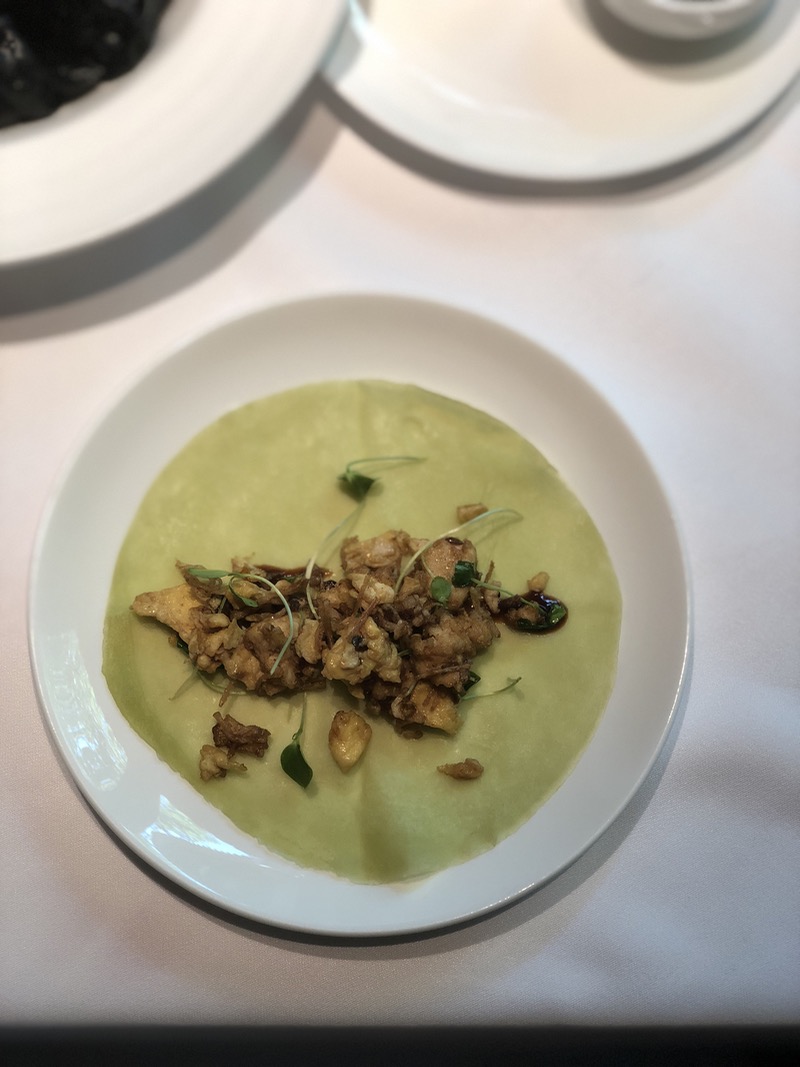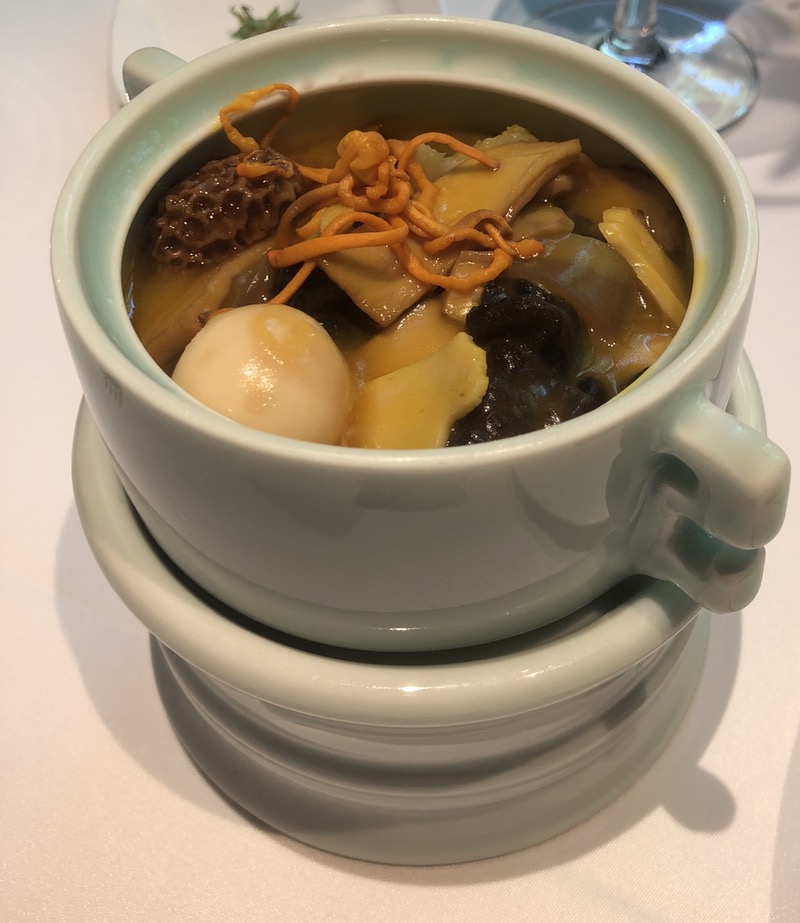King’s Joy Beijing: new wave vegetarianism swells in China
Vegetarianism (sushizhuyi) has swelled in China in tune with contemporary trends and so did its Michelin stars. King’s Joy (in Chinese Jing Zhao Yin) has lured celebrities and middle-class intelligentsia of Beijing even before it was awarded two stars in the inaugural 2020 Michelin Guide for the megapolis. Lucratively staged inside siheyuan, a traditional courtyard residence in the narrow Wudaoying Hutong alley, now so trendy in Beijing, the fine restaurant pampers its customers, English speakers inclusive. Once an aristocratic appendage to the Forbidden City, the old Beijing cultural district is where the Confucius Temple and Lama Temple have dwelled for centuries.
Literally, a bamboo garden replenishing the green spirit in the heart of the Chinese capital, King’s Joy 京兆尹 is to Beijing what Tal Ronnen’s Crossroads is to Los Angeles. Elegant, sleek, upscale vegetarian restaurant, yet its creativity and charity surpass even the Hollywood king of trendy plant-based fare. As the harpist plucks the strings under the ecological flash of daylight, you wonder if the t-shirt he wears is appropriate, but like in LA, in China restaurants accommodate any fashion, just make sure you can afford the meal. King’s Joy is expensive by Beijing’s standards. Yet, what you are about to savour is one of the best healthy, organic, sustainable, vegetarian dining experiences in the world. I tried the widely reported best in Europe (Barcelona, London, Paris, Prague, Vienna, Zurich,…), Northern America (LA, Miami, New York, San Francisco), the Middle East, North Africa, Japan and Hong Kong and the fine Chinese cum Western light cuisine at King’s Joy measured up and I dare to admit even slightly above these top flesh-free restaurants. A higher challenge even as we ordered half of the dishes from its extra-large digital menu at our daily visits.
King’s Joy shares traditional Chinese charity spirit by providing free tea for pedestrians and on the first and fifteenth day of the lunar calendar also free porridge.
The pentacle of health in Chinese culinary philosophy
The term used for vegetarian food in China is sushi, meaning ‘simple’ or ‘plain’ food, which is the only commonality with the simple Japanese sushi consisting of sticky rice and fish or seafood, perhaps wrapped in seaweed. King’s Joy “promotes environmental protection and nursing, and a healthy organic diet that is timely, diverse, five-color, five-flavored and five-lined. The ingredients are preferably selected in the order of wild, semi-wild, natural, super-organic, organic and green.” From the Chinese translation I am not sure what “super-organic” or “semi-wild” mean, but you get it, natural diversity is served to improve your health when dining out at King’s Joy. The necessity for the growing Chinese population to include more sustainable, plant-based food in the regular diet is now utterly delectable for the Beijingers.
The food is steeped in history yet with a firm footing in the present progress: “In order to show the taste of the ingredients, our food is low-sugar, low-fat, low-calorie, no-additives and preservatives.”
The new wave vegetarianism (sushizhuyi) swell in China
Vegetarianism was once widely spread within the Buddhist Chinese population, but even centuries before (as early as during the Shang dynasty 1766 – 1122BC) since confucianism and tao philosophy include pacifism, respect to nature and animal welfare in their core belief (entitlement vegetarianism). In his thesis on Chinese vegetarianism Brendan Nuse writes: “Since the opening-up reforms of the late 1970s, a new form of Chinese vegetarianism focused on the endangerment has emerged. This new Chinese vegetarianism is not one that a certain religion or ideology imposes, and, unlike Western vegetarianism, it is not a social movement, but a tool that Chinese people use to grapple with contemporary problems such as environmental degradation, obesity, and food safety concerns.” Catering to the middle class, university educated, Chinese concerned about health and safety of meat consumption in the scandal-ridden country, King’s Joy timely moved from its original, five-decades-old, location in Taiwan.
The popularity of clean, vegetable-based food is increasing in China. In Shanghai Tony Lu, head chef at his elegant vegetarian restaurant Fu He Hui got his first Michelin star in the 2017 edition of Michelin guide China that has not included Beijing in its rankings as of 2018 yet. So much is brewing on the Chinese vegetarian gourmet dining scene in the mighty country’s capital, Beijing, that I suspect that the Chinese vegetarian Chef Ci Shi of King’s Joy will be a hot candidate in its inaugural Beijing edition. Revising this article in 2020 literally confirmed my gut feelings.
Clean design that nourishes health
The indoor space balances the historical nature of the building. The spacious elegant dining rooms designed by Beijing architect Yung Ho Chang, MIT Professor of Architecture, are modestly sized (King’s Joy accommodates up to 210 guests, including the VIP rooms) for a Chinese restaurant. Traditional building materials such as tile, brick, wood and hemp were used in the interior, while high tech tools ease your experience. Digital, yet taste buds teasing photographs of the dishes are presented on a tablet, a click away, type number of portions and “complete order” with the clack of your fingertips. To our relief, first timers are eagerly helped by the English-speaking staff. Toilet-going is an anxiety rising experience to converse about after your visit. I won’t develop on the story here, just a hint – the door “should not” open. The design merges nature with technology brilliantly – negative ion sprays for cooling and cleansing pollutants from the urban-heavy outside smog create an oasis in the midst of the infamously poor air of Beijing.
The harpist sets the slow dining pace for you to savour the meal mindfully. At lunch fellow expats relished its holistic aural embrace next to the clean food so desired by the elites (these who can afford it in China) who conduct business and enjoy dinner with wine like us at our next visit at King’s Joy. Click on the first image below for a full view.
The Bamboo charcoal black truffle radish pastries were Michelin star worth morsels I could eat every day. The fairy-light charcoal beehive pastry nested white radish freshness inside its fragrant shell. Sweet sauce topped Vietnamese spring rolls westernised with a slice of avocado. My husband relished in the Spicy Dried Bean Curd starter with a devilish hedonism.
Lotus seeds, simply boiled with green asparagus and lightly seasoned are served warm in an earthen pot.
Clear, healthful soups are medicine in China, but the Stewed yam with red bean and coix seed broth tasted slightly better than the herbal potions dispensed by TCM specialists. More fun were the Vegetable soup dumplings, bite, let the steam off a bit and slurp the juice before devouring the sizzling hot vegetables inside (beware, veggies keep heat longer than the meat served usually inside these Shanghainese ravioli).
Mushroom lovers rejoice! Stewed konjac (the almost calorie-free diet fungus) combined with fragrant matsutake and king oyster mushroom hotpot nourishes the belly, joints and the soul. We did not like however, the Soup with fungus and walnuts, the Spicy morels with stir-fried tofu, and worse even were the Bamboo charcoal vegetable dumplings, overcooked and not short of tasteless. Healthy house recipes of Zhang Daqian 張大千, a renowned calligrapher and artist were incorporated into King’s Joy menu. Jasmine Rice with Asparagus, Sunflower Braised Bamboo Shoots, Taiwan Mushroom Tofu and Basil, and Pine Mushroom with Cheese Balls were the favourites of the healthy food loving artist, who befriend the founder of King’s Joy, even donating two scrolls to decorate the restaurant’s walls.
Sweet and sour lotus shoots play on the Shanghai drum preferring it bold and sweet, while the Sweet and sour Land Ginseng served in a Parmesan Shell was a fusion of the West with the fried delectables of the East. More Western flavours emerge from the kiln oven, where bread, biscuits and pizza are baked to please the home-longing diners.
Tempeh stacked vertically in a stash of onion leaves with an extra ordered side of Stir-fried rice with vegetables fills the big bellies or those with fast metabolism like myself. The Chun Miao Sauce Egg Tofu with Chinese Pancake was solid too, but the unbeatable Vegetarian Beijing Duck with crispy rice mixed in hit the jackpot. Perhaps better than most of the real duck dishes in the city of its delectable fame! Spread it on the warm pancakes, add some hoisin or hot chilli sauce and devour without guilt. This mock meat “fanghun” dishes have been popular in China since the Song Dynasty (10–13th c.). Overall the dishes are rich in sauces, seasoning and excellently creative with meat substitutions.
No need to order desserts, as per tradition in China fruits fill in for the sweet cravings. At King’s Joy a bowl of fresh strawberries in late spring, ripe pineapple or other pure fruits are complimentary offered at the end of the meal.
Cultured dining in authentic Chinese style
The Afternoon Tea in Chinese fashion titled “High Tea Musical Listening” is very popular and includes desserts. The inner courtyard under open skies seems ideally set up for this occasion, if the pollution recedes.
The tea selection at such a hedonistic, peace-tuning, dining room matches to the broad biodynamic or organic wine list. We enjoyed the La Forge de Tart Burgundy as well as one of the best Aussie Pinnots by Phillip Bass with dinner. At lunch we sipped on Wu-yi large black robe oolong tea, the grand dame of Chinese semi-fermented teas. A tea library by the entrance signalises the seriousness of the tea tasted, served and pondered about at King’s Joy. Like a lounge it comfortably welcomes you or closes your dining experience at the restaurant.
Other creative beverages include a warm Black rice and coix soy milk, a liquid breakfast more than delectable digestive sans alcohol. I could not finish it, it just tasted strangely heavy. Drip coffee (machinery by the Japanese Haro) has infiltrated the tastes even of the tea nation. Simple juices like the risqué bitter melon (sometimes trying something new does literary does not pay off! Terrible, too healthy tasting, even the waitress empathised over my disgust) but also orange, pineapple et al. For a super healthy drink order the Matsutake mushroom broth served in teapot. Black truffle wine on the menu is yet another vanity of the Chinese nouveau riche excess, and I was not even faintly tempted to try that. Further, fake aromas surprised me at a place that claims “no-additives” as their philosophy.
The original King’s Joy brand established by a Canadian Chinese David Yin in Taipei over a half century ago was significantly upscaled with his Chinese partners in Beijing. Local celebrities do not hesitate to flood in. If you want to balance your business or leisure trip to China, venture in!
A service fee of about 9% is included, so tipping is advised only if you do not consume any costly alcoholic beverages.
2 Wudaoying Hutong, Dongcheng Qu, Beijing Shi, China, 100027
+86 10 8404 9191
Daily 11:30am – 10pm























